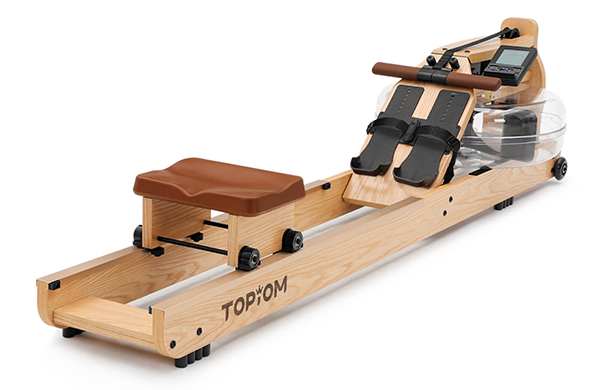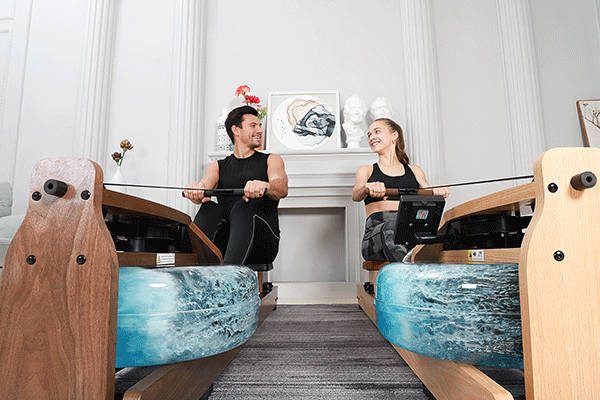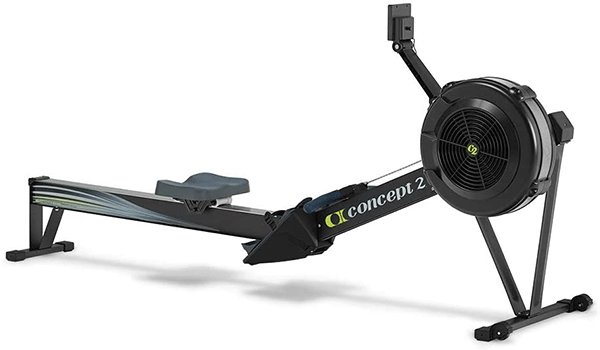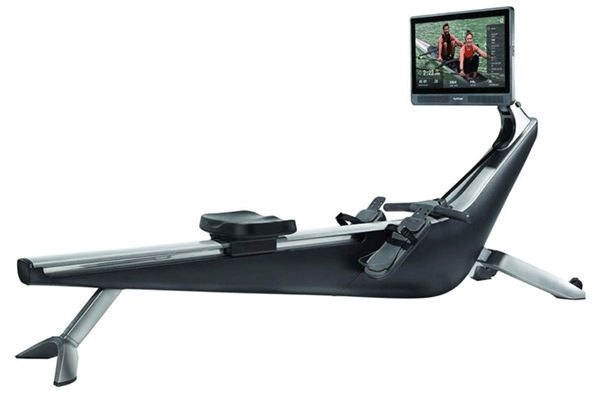Indoor rowers bring the pleasure of rowing on the lake into our houses. But choosing a suitable rowing machine is a big headache. The key to making a smart decision is to figure out your needs. Consider these 6 questions before buying a rowing machine. After that, there is one more important step: to learn rowing machine resistance types.
Why Resistance Type Is Important?
Each type usually has a list of unique characteristics tied to them, ranging from noise level, price, size, and storage capabilities.
If you wanna simplify the searching of rowing machines, then it is important to learn resistance types.
Once you figure out your preferred one, your search becomes much easier and more efficient. You can rule out all other rowers that aren’t in your category and vastly narrow down the search field.
Resistance Types
Rowing machines on the market can be mainly available in 5 kinds: water, air, magnetic, and hydraulic and cable/cord resistance.
 Most rowing machines use one of the types to provide resistance for the rower.
Plus, there are also some rowing machines use a combination of air/magnetic resistance.
Following is a full breakdown of rowing machine resistance types, including characteristics, advantages, and disadvantages.
Most rowing machines use one of the types to provide resistance for the rower.
Plus, there are also some rowing machines use a combination of air/magnetic resistance.
Following is a full breakdown of rowing machine resistance types, including characteristics, advantages, and disadvantages.

 Nothing is better than jumping into a row boat on a picturesque lake and starting a peaceful rowing workout.
However, life isn’t always as good as this – especially if you live in a city where row boats, lakes and peace don’t come easy!
This is where water rowing machines come in.
Water rowing machines provide a more realistic feel than air, magnetic or hydraulic alternatives.
They also tend to have a quiet and smooth stroke. Water rowing machine is relatively quiet when in use – even when you’re rowing fast.
Nothing is better than jumping into a row boat on a picturesque lake and starting a peaceful rowing workout.
However, life isn’t always as good as this – especially if you live in a city where row boats, lakes and peace don’t come easy!
This is where water rowing machines come in.
Water rowing machines provide a more realistic feel than air, magnetic or hydraulic alternatives.
They also tend to have a quiet and smooth stroke. Water rowing machine is relatively quiet when in use – even when you’re rowing fast.
 Such rowing machine uses paddles suspended in a tank of water for resistance.
When you pull back on the handle, the paddles revolves in the water. The mass of the moving water creates a drag against the paddles and produces resistance.
Like air rowing machines, resistance on a water rower is variable.
That means the amount of resistance a rower will feel is dependent on their rowing intensity.
The harder the handle is pulled, the faster the paddles spin. The faster the paddles spin, the more difficult it gets to pull the handle, and the user feels more resistance.
In addition, the rowing experience can be further adjusted by adjusting the water level in the tank.
Changing water level,however, doesn’t change resistance. But it does change the rowing feeling. The more water, the “heavier” the rowing will feel (like rowing with passengers in a boat). The less water, the “lighter” the rowing will feel (like rowing by yourself).
Such rowing machine uses paddles suspended in a tank of water for resistance.
When you pull back on the handle, the paddles revolves in the water. The mass of the moving water creates a drag against the paddles and produces resistance.
Like air rowing machines, resistance on a water rower is variable.
That means the amount of resistance a rower will feel is dependent on their rowing intensity.
The harder the handle is pulled, the faster the paddles spin. The faster the paddles spin, the more difficult it gets to pull the handle, and the user feels more resistance.
In addition, the rowing experience can be further adjusted by adjusting the water level in the tank.
Changing water level,however, doesn’t change resistance. But it does change the rowing feeling. The more water, the “heavier” the rowing will feel (like rowing with passengers in a boat). The less water, the “lighter” the rowing will feel (like rowing by yourself).
 Air rowers are one of the most popular types among professional rowers. They have been around since the 1980s and many consider them the best type of rower.
Air rowers are one of the most popular types among professional rowers. They have been around since the 1980s and many consider them the best type of rower.
 Better models use dampers to alter the flow of air.
While damper setting may sound like “resistance settings”, in fact, it is NOT. As Concept2 says, “damper setting is similar to bicycle gearing: it affects how rowing feels but does not directly affect the resistance.” Differently put, it changes the rowing feeling.
Air rowing machines are very popular for HIIT (high intensity interval training) and Crossfit workouts. They allow users to row intensely for one set and then easy the next, without stopping or changing any settings.
Better models use dampers to alter the flow of air.
While damper setting may sound like “resistance settings”, in fact, it is NOT. As Concept2 says, “damper setting is similar to bicycle gearing: it affects how rowing feels but does not directly affect the resistance.” Differently put, it changes the rowing feeling.
Air rowing machines are very popular for HIIT (high intensity interval training) and Crossfit workouts. They allow users to row intensely for one set and then easy the next, without stopping or changing any settings.

 As you may be able to guess, these rowers use a combination of air and magnetic resistance.
As you may be able to guess, these rowers use a combination of air and magnetic resistance.
 Most rowing machines use one of the types to provide resistance for the rower.
Plus, there are also some rowing machines use a combination of air/magnetic resistance.
Following is a full breakdown of rowing machine resistance types, including characteristics, advantages, and disadvantages.
Most rowing machines use one of the types to provide resistance for the rower.
Plus, there are also some rowing machines use a combination of air/magnetic resistance.
Following is a full breakdown of rowing machine resistance types, including characteristics, advantages, and disadvantages.
Hydraulic Piston Resistance

How Does It Work?
It is achieved by pistons attached to the handles. Users pull against the air or fluid inside the cylinder. Hydraulic rowing machines have either one or two pistons, depending on the model. The Hydraulic rowing machine with 2 pistons is the only type that allows an independent workout for each arm, meaning each arm works out independently of the other. This can be great for rehab and correcting muscle imbalances. These rowers have ‘adjustable’ resistance that is controlled by turning a knob on the piston. The knob controls the amount of fluid allowed to move in-and-out of the piston. Thus, controlling the resistance. And levels usually range from 1-8.Advantages
- Low cost compared to many rowers
- Smaller size, many are foldable
- Quieter than air/ flywheel rowing machines
Disadvantages
- Most models do not provide smooth rowing action.
- Resistance levels change as oil inside heats up. Plus, they may overheat and sometime leak oil.
- Require regular maintenance.
- The build quality on hydraulic-piston rowers can also be a bit lower than other models.
- It is not a good choice for very tall and heavy users.
Characteristics
- Adjustability: The pistons usually have a level setting.
- Price Range: ~$100 – $600
- Size: Smallest footprint
- Noise-level: Quiet
- Storage: Very light weight. Some models have the option to fold up which saves even more space.
- Rowing Motion: Rowing motion provides a good full-body workout, but the motion is typically the least similar to rowing outdoors. Not as smooth as other types.
- Ideal for: People with beginner and intermediate fitness levels. Elderly rowers. Not recommended for athletes.
- Misc: Not the best option for taller users due to the smaller seat rail.
- Popular Brands: Stamina, Kettler
- Most Popular Rower: Stamina 1215 Orbital Rower
Water Resistance
 Nothing is better than jumping into a row boat on a picturesque lake and starting a peaceful rowing workout.
However, life isn’t always as good as this – especially if you live in a city where row boats, lakes and peace don’t come easy!
This is where water rowing machines come in.
Water rowing machines provide a more realistic feel than air, magnetic or hydraulic alternatives.
They also tend to have a quiet and smooth stroke. Water rowing machine is relatively quiet when in use – even when you’re rowing fast.
Nothing is better than jumping into a row boat on a picturesque lake and starting a peaceful rowing workout.
However, life isn’t always as good as this – especially if you live in a city where row boats, lakes and peace don’t come easy!
This is where water rowing machines come in.
Water rowing machines provide a more realistic feel than air, magnetic or hydraulic alternatives.
They also tend to have a quiet and smooth stroke. Water rowing machine is relatively quiet when in use – even when you’re rowing fast.
How Does It Work?
 Such rowing machine uses paddles suspended in a tank of water for resistance.
When you pull back on the handle, the paddles revolves in the water. The mass of the moving water creates a drag against the paddles and produces resistance.
Like air rowing machines, resistance on a water rower is variable.
That means the amount of resistance a rower will feel is dependent on their rowing intensity.
The harder the handle is pulled, the faster the paddles spin. The faster the paddles spin, the more difficult it gets to pull the handle, and the user feels more resistance.
In addition, the rowing experience can be further adjusted by adjusting the water level in the tank.
Changing water level,however, doesn’t change resistance. But it does change the rowing feeling. The more water, the “heavier” the rowing will feel (like rowing with passengers in a boat). The less water, the “lighter” the rowing will feel (like rowing by yourself).
Such rowing machine uses paddles suspended in a tank of water for resistance.
When you pull back on the handle, the paddles revolves in the water. The mass of the moving water creates a drag against the paddles and produces resistance.
Like air rowing machines, resistance on a water rower is variable.
That means the amount of resistance a rower will feel is dependent on their rowing intensity.
The harder the handle is pulled, the faster the paddles spin. The faster the paddles spin, the more difficult it gets to pull the handle, and the user feels more resistance.
In addition, the rowing experience can be further adjusted by adjusting the water level in the tank.
Changing water level,however, doesn’t change resistance. But it does change the rowing feeling. The more water, the “heavier” the rowing will feel (like rowing with passengers in a boat). The less water, the “lighter” the rowing will feel (like rowing by yourself).
Advantages
- Quiet in operation
- Smooth, consistent resistance through stroke
- Many like the ‘whoosh’ of water in the tank
- Very little maintenance needed – the water needs changing occasionally, but that’s about it.
- water rowers don’t have a ‘flat spot’ where the resistance drops during the stroke cycle.
Disadvantages
- Tend to have larger footprint than other types of rowing machines
- Prices start at a higher point
Characteristics
- Adjustability: Such resistance is considered ‘variable’, based on how hard users pull. Rowing feeling can be further adjusted by managing the amount of water in the water tank.
- Price Range: ~$700 – $2,000
- Size: Large footprint due to a longer seat rail. Fairly heavy due to the water tank.
- Noise-level: Only the wooshing sound in the water tank.
- Storage: A lot of the rowers can be stored standing upright. When stored upright, it only takes the space of a dining room chair.
- Rowing Motion: Closely resembles outdoor rowing.
- Ideal for: People of all fitness levels (beginner, intermediate, advanced). People who want aesthetically pleasing rower to have in their living room.
- Misc: Possibly the closest experience to rowing on water.
- Popular Brands: WaterRower, First Degree Fitness
- Most Popular Rower: WaterRower Natural Rowing Machine
Air Resistance
 Air rowers are one of the most popular types among professional rowers. They have been around since the 1980s and many consider them the best type of rower.
Air rowers are one of the most popular types among professional rowers. They have been around since the 1980s and many consider them the best type of rower.
How Does It Work?
These rowing machines get their resistance from a spinning flywheel. The wheel is connected by a chain to the rowing handle and as you pull this spins the flywheel. The faster you row, the faster the flywheel spins through the air, thus the greater the resistance. Therefore, like water resistance, air resistance is also variable. Better models use dampers to alter the flow of air.
While damper setting may sound like “resistance settings”, in fact, it is NOT. As Concept2 says, “damper setting is similar to bicycle gearing: it affects how rowing feels but does not directly affect the resistance.” Differently put, it changes the rowing feeling.
Air rowing machines are very popular for HIIT (high intensity interval training) and Crossfit workouts. They allow users to row intensely for one set and then easy the next, without stopping or changing any settings.
Better models use dampers to alter the flow of air.
While damper setting may sound like “resistance settings”, in fact, it is NOT. As Concept2 says, “damper setting is similar to bicycle gearing: it affects how rowing feels but does not directly affect the resistance.” Differently put, it changes the rowing feeling.
Air rowing machines are very popular for HIIT (high intensity interval training) and Crossfit workouts. They allow users to row intensely for one set and then easy the next, without stopping or changing any settings.
Advantages
- Wide range of resistance available replicating rowing on water.
- ‘Automatic’ resistance adjusts to your stroke rate.
- Smooth action.
- Little wear and tear to mechanism.
- Always matches your capabilities. If you go slower, the resistance becomes lower. if you go faster, it goes up.
Disadvantage
- Can be noisy for indoor use
Characteristics
- Adjustability: Resistance is ‘variable’ based on the users rowing intensity. Higher-priced models usually have a damper to adjust the rowing feeling.
- Price range: ~$300 – $1,300. Air rowing machines are at the mid-to-high end of the price range.
- Noise-level: Loudest of all types due to the constant spinning of the flywheel.
- Size: Usually has larger footprint relative to the other types due to a longer seat rail.
- Storage: Most have an option to take the unit apart/ fold the unit in half for storage.
- Rowing motion: Resembles outdoor rowing. Smooth and strong.
- Ideal for: People of all fitness levels (beginner, intermediate, advanced). All people looking to get a total body workout. This type of machine is preferred by most serious rowers for out of season training as it more closely replicates the action of rowing on water.
- Misc: The longer rails make it suitable for taller rowers with long legs.
- Popular Brands: Concept2
Magnetic Resistance
Magnetic rowers often give a smooth rowing action and as mentioned earlier are very quiet. So, it is especially popular for use in the home. People really enjoy rowing while watching TV but still feel they can get a good quality rower with strong resistance.
How Does It Work?
Magnetic rowing machines use a magnetic brake system to create resistance. As a metal flywheel spins, a magnet can be moved closer or farther away to create more or less resistance. Its levels are adjusted using either mechanical sliders or digitally by the console controls. This video might give you a clear idea. Unlike variable water or air rowing machines, once you set the resistance level on a magnetic rower it stays the same no matter how fast or slow you row. The resistance can be controlled by manually turning a dial or pressing a button on the monitor.Advantages
- Very quiet in operation (some are almost silent)
- Wide range of resistance levels
- Usually smaller than air or water rowers
- Little maintenance required.
Disadvantages
- They don’t simulate rowing on water (not a problem if you just want a workout)
Characteristics
- Adjustability: Usually has a level setting. Can adjust by turning a knob or pressing a button on higher priced models.
- Price Range: ~$200 – $1,400
- Size: Usually has a bigger footprint due to a longer seat rail.
- Noise-level: Quiet
- Storage: Most have an option to take the unit apart/ fold the unit in half for storage.
- Rowing Motion: Similar to air-resistance but not as smooth or strong.
- Ideal for: People of all fitness levels (beginner, intermediate, advanced). People who want great workout without the noise of air or water rowers.
- Misc: Its size is similar to an air-rower but it isn’t noisy. Cost is usually mid-range.
Air & Magnetic Combination Resistance
 As you may be able to guess, these rowers use a combination of air and magnetic resistance.
As you may be able to guess, these rowers use a combination of air and magnetic resistance.
How Does It Work?
The dual resitance rower uses a combination of air and magnets to provide the resistance. It fuses essentially unlimited air resistance with several levels of magnetic resistance.Advantages
Such innovation gives the advantage of air – a realistic rowing feel of increasing resistance as you pull harder, with the functionality of a magnetic mechanism, that is, the ability for the computer to change the level of resistance. Such design provides unlimited potential to workout programs.Disadvantages
The downside is that they don’t provide the realistic, variable rowing feeling of air-only models and they don’t provide the silent rowing stroke of magnetic-only models.Characteristics
- Adjustability: Low-end power of ‘adjustable’ magnetic resistance combines with high-end power of ‘variable’ air resistance.
- Price Range: $300 – $1,500
- Size: Large footprint due to a longer seat rail.
- Noise-level: Quieter than an air-only rower but louder than magnetic-only rower. Fan will not spin as fast as air-only rower which makes it slightly quieter.
- Storage: Most can be folded for storage.
- Rowing Motion: Closely resembles outdoor rowing but resistance will feel heavier.
- Ideal for: People of all fitness levels (beginner, intermediate, advanced). Rowers looking to have strong, adjustable resistance, pre-set workout programs on high-end models.
- Misc: Some model have ability to control resistance in handle.
- Price Range: ~$200 – $1,400
- Popular Brands: LifeCore, Sole
- Most Popular Rower: LifeCore R100 Rowing Machine

